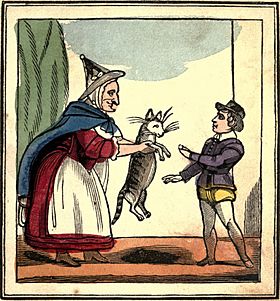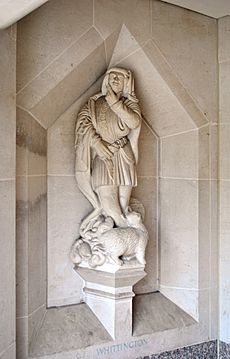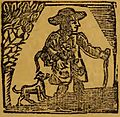Dick Whittington and His Cat facts for kids
Dick Whittington and His Cat is a famous English folklore story. It's about a poor boy named Dick Whittington who becomes very rich. He even becomes the Lord Mayor of London! The story says he got his wealth by selling his cat to a country full of rats.
This tale is based on a real person, Richard Whittington (who lived from about 1354 to 1423). He was a very wealthy merchant and indeed became Lord Mayor of London three times. However, the real Whittington was not poor as a child. Also, there isn't much proof that he owned a special cat or that it made him rich.
Another part of the legend says Dick tried to run away from his job as a kitchen helper. But as he left London, he heard the famous Bow bells. They seemed to promise him he would be mayor one day, so he turned back.
For a long time, especially around Christmas, this story has been a popular British pantomime show.
Contents
The Story of Dick Whittington
The story of Dick Whittington and his cat has been told for hundreds of years. The first written versions appeared in the early 1600s. This was more than 150 years after the real Richard Whittington had died.
How the Story Began
One of the earliest surviving written versions is a song from 1612 by Richard Johnson. This song already mentions Dick making his fortune with his cat. It also includes the part where Dick tries to run away but is called back by the London bells.
The first known story in prose (like a book) was published in 1656. It was called The Famous and Remarkable History of Sir Richard Whittington. This version said the bells were from Bow Church (St Mary-le-Bow). It also said Dick heard them at a place called Bunhill. Later versions of the story say he reached Holloway before turning back.
Today, there's a special spot called the Whittington Stone at the bottom of Highgate Hill. Many people believe this is where Dick Whittington stopped and heard the famous bells.
Dick's Journey to London
Dick Whittington was a poor orphan boy. He lived in the countryside, perhaps in Lancashire. He heard rumors that the streets of London were paved with gold. So, he decided to go there to find his fortune.
When he arrived, he was cold and hungry. He fell asleep near the home of a rich merchant named Fitzwarren. Mr. Fitzwarren was kind and gave Dick a place to stay. He also hired Dick to work as a scullion (a kitchen helper).
Dick and His Cat
Dick was given a small room in the garret (attic) of the Fitzwarren house. This room was full of rats and mice! Dick had bought a cat for just one penny he earned by shining shoes. This cat was very good at catching rodents. It became Dick's best friend and helped him sleep at night.
Mr. Fitzwarren decided to send a merchant ship, the Unicorn, on a trade trip. He had a rule that everyone in his house should send something valuable on the ship to be sold. Dick didn't have much, so he sent his cat. Some stories say Dick willingly sent his cat, hoping it would bring him wealth. Other stories say Mr. Fitzwarren made him do it.
The Bells Call Him Back
Dick was not happy as a scullion. He worked hard but didn't get paid. Also, the cook, Mrs. Cicely, was often mean to him. One day, he decided he couldn't take it anymore and ran away.
He ran as far as Bunhill or Holloway. There, he heard the "London Bells" or "Bow bells" ringing. They seemed to say:
"Turn again Whittington, Lord Mayor of London!"
This message convinced Dick to go back to London. He believed it was a sign that he was meant for great things.
From Rags to Riches
Meanwhile, the Unicorn ship was blown off course to the Barbary Coast. This was a place ruled by a Moorish king. The king bought all the cargo from the ship. He then invited the English traders to a big feast.
But the banquet was ruined by swarms of rats and mice! The English business agent told the king they had a creature that could get rid of the pests. Dick Whittington's cat was brought in and quickly chased away all the rodents. The king was so impressed that he paid a huge amount of gold for the cat. He was even happier when he learned the cat was pregnant! He paid much more for the cat than for all the other goods combined.
When the ship returned to London, Mr. Fitzwarren heard about the amazing profits. He called Dick, who was still a scullion, into his fancy room. Mr. Fitzwarren told Dick that the money from the cat made him richer than the merchant himself!
Later, Dick married Mr. Fitzwarren's daughter, Alice. He joined his father-in-law's business. Just as the bells predicted, Dick Whittington became the Lord Mayor of London three times! He used his wealth to help others. He built a college, a church, and even helped rebuild Newgate Prison. He also famously burned the papers that showed the King owed him money, helping the country.
Whittington Stone
Today, on Highgate Hill in London, you can find a statue of Whittington's legendary cat. It's located in front of Whittington Hospital. This is believed to be the spot where Dick heard the Bow Bells calling him back to London. The cat statue was added to the Whittington Stone in 1964.
Some old books say Dick ran away as far as "Holloway," which is near where the stone is. It's not clear exactly how old the tradition of the stone is. Some historians think the idea of Dick stopping at Holloway was added to the story later on.
Where the Story Comes From
The story of Dick Whittington and his cat is only loosely based on the real Richard Whittington. While the real Whittington did marry a woman named Alice Fitzwarren, there's no strong proof he ever owned a cat, or that a cat made him rich.
No one knows for sure how the cat story became linked to Whittington. Some people thought "cat" might have been a mistake for a French word meaning "purchase" (achat). Others thought it might refer to a type of boat used for carrying coal. However, these ideas are not widely accepted today.
There are some old pictures and buildings that people thought might show the cat story was known even before the 1600s. But many of these ideas have been proven wrong or are uncertain. For example, a famous engraving of Whittington with a cat might have originally shown him with a skull, which was later changed to a cat to make the picture more popular.
Similar Stories Around the World
Historians have found many similar tales from other countries and older times. These stories often feature a hero who becomes rich by selling a cat in a place that desperately needs one because of rodents. This type of story is known as the "Whittington's Cat" motif in folklore studies.
For example, there's an Italian story from the 16th century about a merchant who sold his cat to the king of the Canary Islands. Another Italian tale from the 15th century is called "Tale of the She-cats." A German story from the 13th century, set in Venice, also tells of a poor man who gets rich by sending two cats on a trade trip.
There's even a Persian story from the 10th century about a widow's son who made his fortune in India with his cat. These similarities show that the idea of a "lucky cat" bringing wealth was a popular theme in many cultures long ago.
The famous fairy tale "Puss in Boots" also shares some similarities with the Whittington story.
Stage Shows and Adaptations
The story of Dick Whittington and his Cat has been turned into many different kinds of stage shows, including puppet plays, operas, and pantomimes.
Puppet Shows
One of the earliest records of the story being performed is from 1668. A famous puppeteer named Martin Powell put on "Whittington and his Cat" shows in the early 1700s. His shows were so popular that people would skip church to go see them! The puppet shows often added funny characters like "Old Madge, the jolly Chamber-maid."
Operas
There have been several opera versions of the story. One opera called Whittington was performed in London in 1874. Another comic opera, Dandy Dick Whittington, played in 1895.
Pantomimes
The first recorded pantomime version of the story was in 1814. In these shows, the main character, Dick, is often played by an actress, known as the principal boy. The cat is usually named Thomas, Tommy, or Mouser.
Pantomimes often add a villain, like the "King Rat," who Dick and his cat must defeat. In many versions, Dick and his cat travel to Morocco. There, the cat gets rid of all the rats for the Sultan, who then rewards Dick with half of his wealth.
The "Dick Whittington" pantomime is still very popular today, especially around Christmas. Many famous actors have performed in these shows over the years.
Images for kids
-
Samuel Lysons' version with a smiling cat
See also
 In Spanish: Dick Whittington and His Cat para niños
In Spanish: Dick Whittington and His Cat para niños







